engine INFINITI QX50 2020 Repair Manual
[x] Cancel search | Manufacturer: INFINITI, Model Year: 2020, Model line: QX50, Model: INFINITI QX50 2020Pages: 580, PDF Size: 7.43 MB
Page 260 of 580

The vehicle is equipped with a shark fin an-
tenna and an antenna pattern is printed in-
side the rear window.
CAUTION
∙ Do not place metalized film near the rearwindow glass or attach any metal parts
to it. This may cause poor reception or
noise.
∙ When cleaning the inside of the rear win- dow, be careful not to scratch or damage
the rear window antenna. Lightly wipe
along the antenna with a dampened soft
cloth. When installing a CB, ham radio or car phone
in your vehicle, be sure to observe the follow-
ing precautions; otherwise, the new equip-
ment may adversely affect the engine control
system and other electronic parts.WARNING
∙ A cellular phone should not be used for
any purpose while driving so full atten-
tion may be given to vehicle operation.
Some jurisdictions prohibit the use of cel-
lular phones while driving.
∙ If you must make a call while your vehicle is in motion, the hands free cellular phone
operational mode is highly recom-
mended. Exercise extreme caution at all
times so full attention may be given to
vehicle operation.
∙ If you are unable to devote full attention to vehicle operation while talking on the
phone, pull off the road to a safe location
and stop your vehicle.
2nd row
LHA4565
ANTENNA CAR PHONE OR CB RADIO
4-44Monitor, climate, audio, phone and voice recognition systems
Page 262 of 580
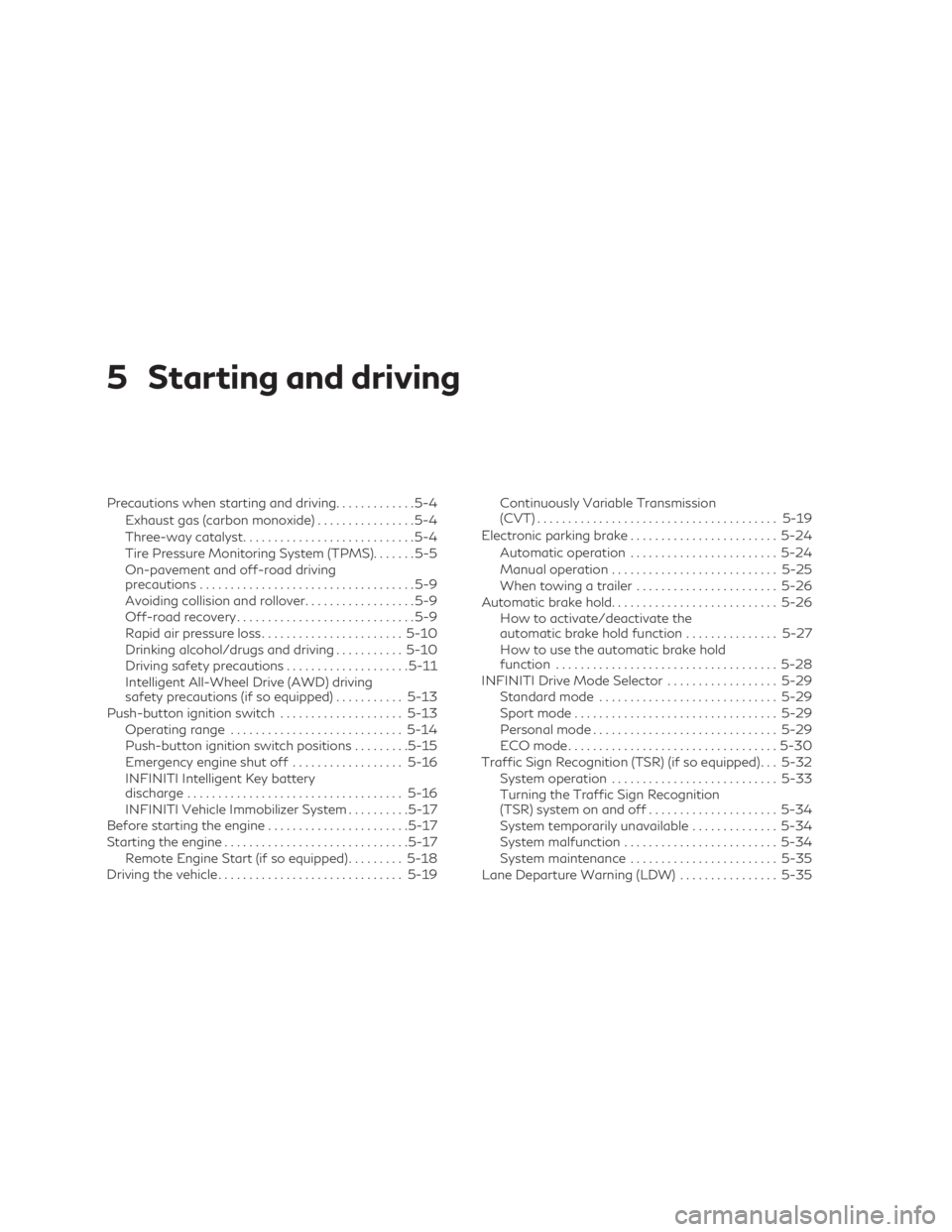
5 Starting and driving
Precautions when starting and driving.............5-4
Exhaust gas (carbon monoxide) ................5-4
Three-way catalyst ............................5-4
Tire Pressure Monitoring System (TPMS) .......5-5
On-pavement and off-road driving
precautions ...................................5-9
Avoiding collision and rollover ..................5-9
Off-road recovery .............................5-9
Rapid air pressure loss ....................... 5-10
Drinking alcohol/drugs and driving ...........5-10
Driving safety precautions ....................5-11
Intelligent All-Wheel Drive (AWD) driving
safety precautions (if so equipped) ...........5-13
Push-button ignition switch ....................5-13
Operating range ............................ 5-14
Push-button ignition switch positions .........5-15
Emergency engine shut off ..................5-16
INFINITI Intelligent Key battery
discharge ................................... 5-16
INFINITI Vehicle Immobilizer System ..........5-17
Before starting the engine .......................5-17
Starting the engine .............................. 5-17
Remote Engine Start (if so equipped) .........5-18
Driving the vehicle .............................. 5-19Continuously Variable Transmission
(CVT)
....................................... 5-19
Electronic parking brake ........................ 5-24
Automatic operation ........................ 5-24
Manual operation ........................... 5-25
When towing a trailer ....................... 5-26
Automatic brake hold ........................... 5-26
How to activate/deactivate the
automatic brake hold function ...............5-27
How to use the automatic brake hold
function .................................... 5-28
INFINITI Drive Mode Selector ..................5-29
Standard mode ............................. 5-29
Sport mode ................................. 5-29
Personal mode .............................. 5-29
ECO mode .................................. 5-30
Traffic Sign Recognition (TSR) (if so equipped). . . 5-32 System operation ........................... 5-33
Turning
the Traffic Sign Recognition
(TSR) system on and off .....................5-34
System temporarily unavailable ..............5-34
System malfunction ......................... 5-34
System maintenance ........................ 5-35
Lane Departure Warning (LDW) ................5-35
Page 265 of 580
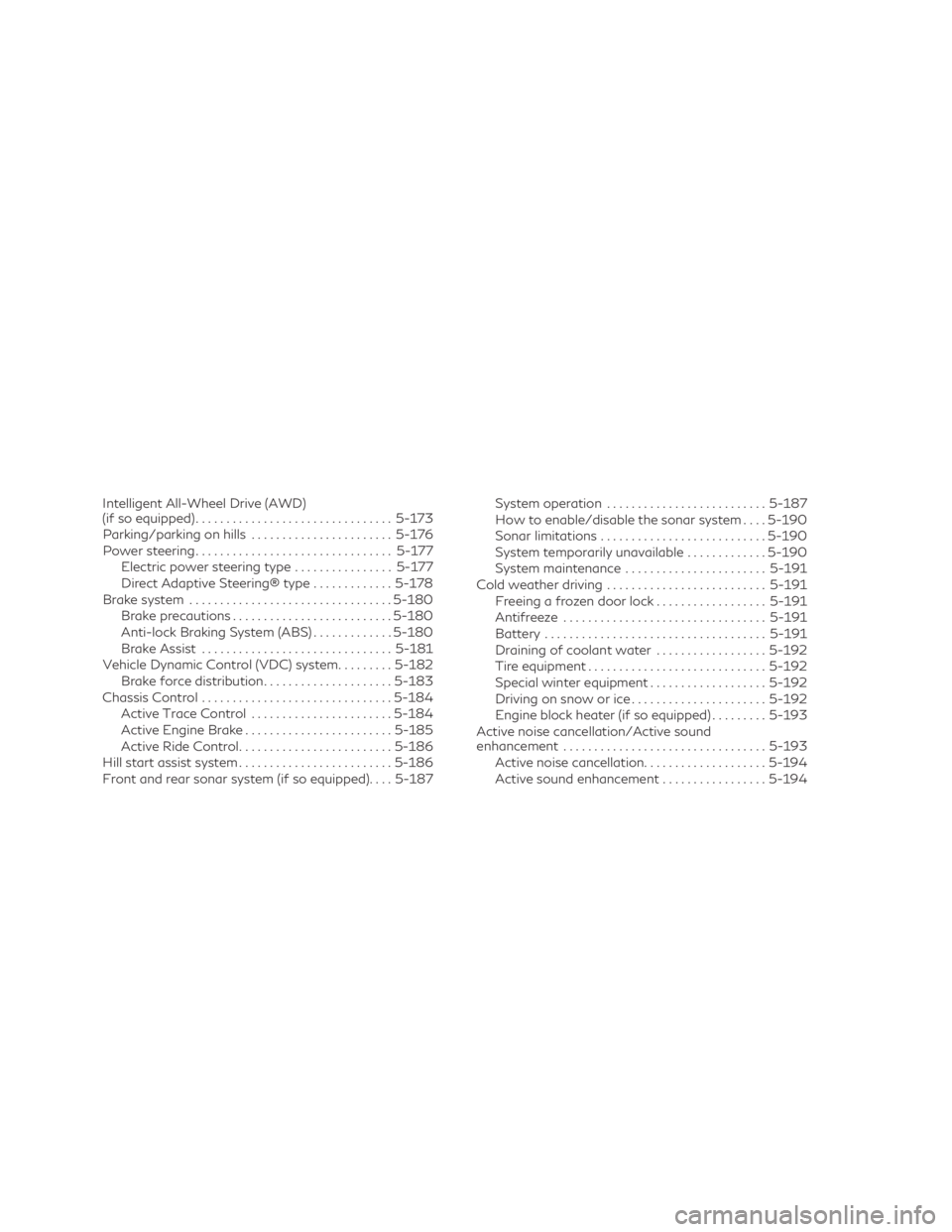
Intelligent All-Wheel Drive (AWD)
(if so equipped)................................ 5-173
Parking/parking on hills .......................5-176
Power steering ................................ 5-177
Electric power steering type ................5-177
Direct Adaptive Steering® type .............5-178
Brake system ................................. 5-180
Brake precautions .......................... 5-180
Anti-lock Braking System (ABS) .............5-180
Brake Assist ............................... 5-181
Vehicle Dynamic Control (VDC) system .........5-182
Brake force distribution .....................5-183
Chassis Control ............................... 5-184
Active Trace Control ....................... 5-184
Active Engine Brake ........................ 5-185
Active Ride Control ......................... 5-186
Hill start assist system ......................... 5-186
Front and rear sonar system (if so equipped) ....5-187 System operation
.......................... 5-187
How to enable/disable the sonar system ....5-190
Sonar limitations ........................... 5-190
System temporarily unavailable .............5-190
System maintenance ....................... 5-191
Cold weather driving .......................... 5-191
Freeing a frozen door lock ..................5-191
Antifreeze ................................. 5-191
Battery .................................... 5-191
Draining of coolant water ..................5-192
Tire equipment ............................. 5-192
Special winter equipment ...................5-192
Driving on snow or ice ...................... 5-192
Engine block heater (if so equipped) .........5-193
Active noise cancellation/Active sound
enhancement ................................. 5-193
Active noise cancellation ....................5-194
Active sound enhancement .................5-194
Page 266 of 580
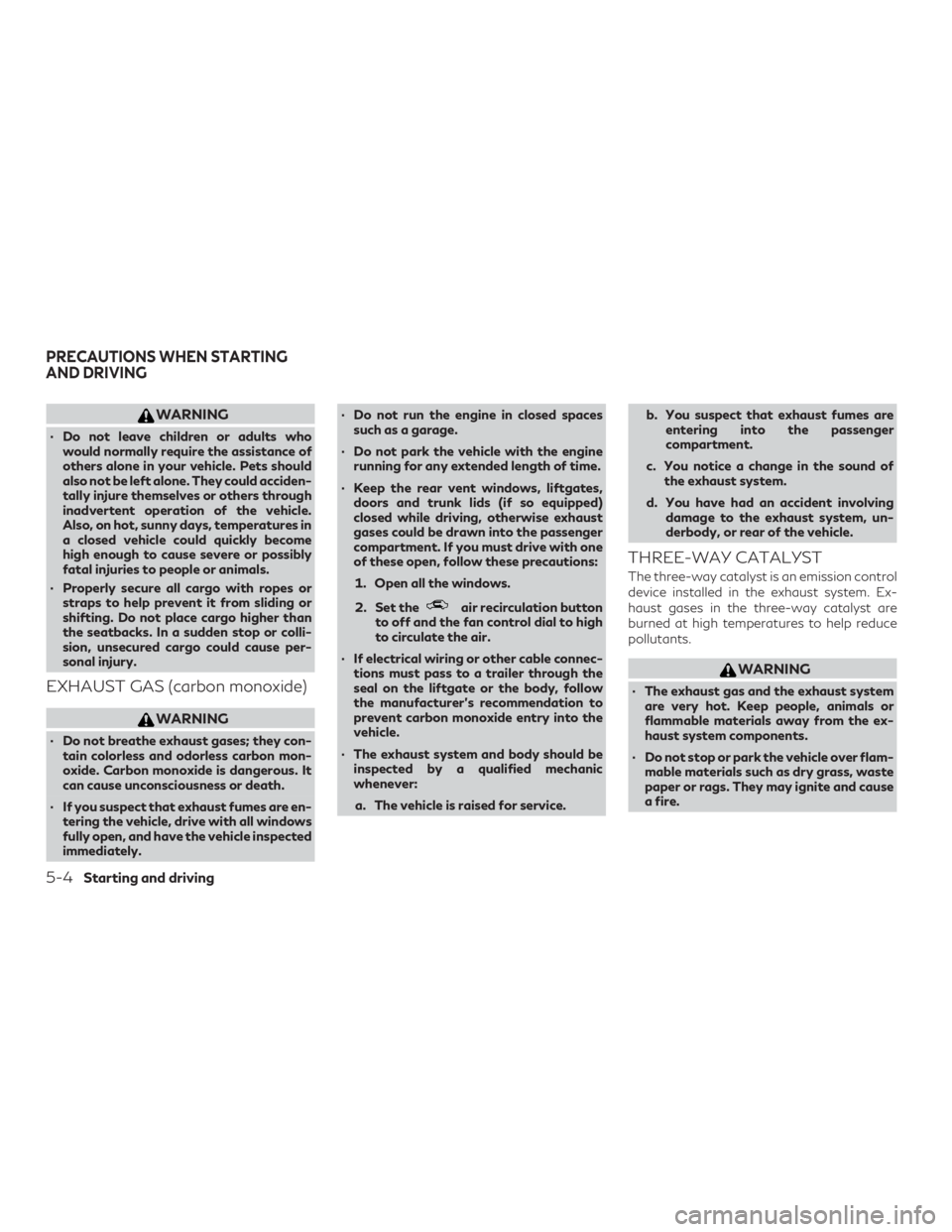
WARNING
∙ Do not leave children or adults whowould normally require the assistance of
others alone in your vehicle. Pets should
also not be left alone. They could acciden-
tally injure themselves or others through
inadvertent operation of the vehicle.
Also, on hot, sunny days, temperatures in
a closed vehicle could quickly become
high enough to cause severe or possibly
fatal injuries to people or animals.
∙ Properly secure all cargo with ropes or straps to help prevent it from sliding or
shifting. Do not place cargo higher than
the seatbacks. In a sudden stop or colli-
sion, unsecured cargo could cause per-
sonal injury.
EXHAUST GAS (carbon monoxide)
WARNING
∙ Do not breathe exhaust gases; they con-tain colorless and odorless carbon mon-
oxide. Carbon monoxide is dangerous. It
can cause unconsciousness or death.
∙ If you suspect that exhaust fumes are en- tering the vehicle, drive with all windows
fully open, and have the vehicle inspected
immediately. ∙ Do not run the engine in closed spaces
such as a garage.
∙ Do not park the vehicle with the engine running for any extended length of time.
∙ Keep the rear vent windows, liftgates, doors and trunk lids (if so equipped)
closed while driving, otherwise exhaust
gases could be drawn into the passenger
compartment. If you must drive with one
of these open, follow these precautions:
1. Open all the windows.
2. Set the
air recirculation button
to off and the fan control dial to high
to circulate the air.
∙ If electrical wiring or other cable connec- tions must pass to a trailer through the
seal on the liftgate or the body, follow
the manufacturer’s recommendation to
prevent carbon monoxide entry into the
vehicle.
∙ The exhaust system and body should be inspected by a qualified mechanic
whenever:
a. The vehicle is raised for service. b. You suspect that exhaust fumes are
entering into the passenger
compartment.
c. You notice a change in the sound of the exhaust system.
d. You have had an accident involving damage to the exhaust system, un-
derbody, or rear of the vehicle.
THREE-WAY CATALYST
The three-way catalyst is an emission control
device installed in the exhaust system. Ex-
haust gases in the three-way catalyst are
burned at high temperatures to help reduce
pollutants.
WARNING
∙ The exhaust gas and the exhaust systemare very hot. Keep people, animals or
flammable materials away from the ex-
haust system components.
∙ Do not stop or park the vehicle over flam- mable materials such as dry grass, waste
paper or rags. They may ignite and cause
a fire.
PRECAUTIONS WHEN STARTING
AND DRIVING
5-4Starting and driving
Page 267 of 580
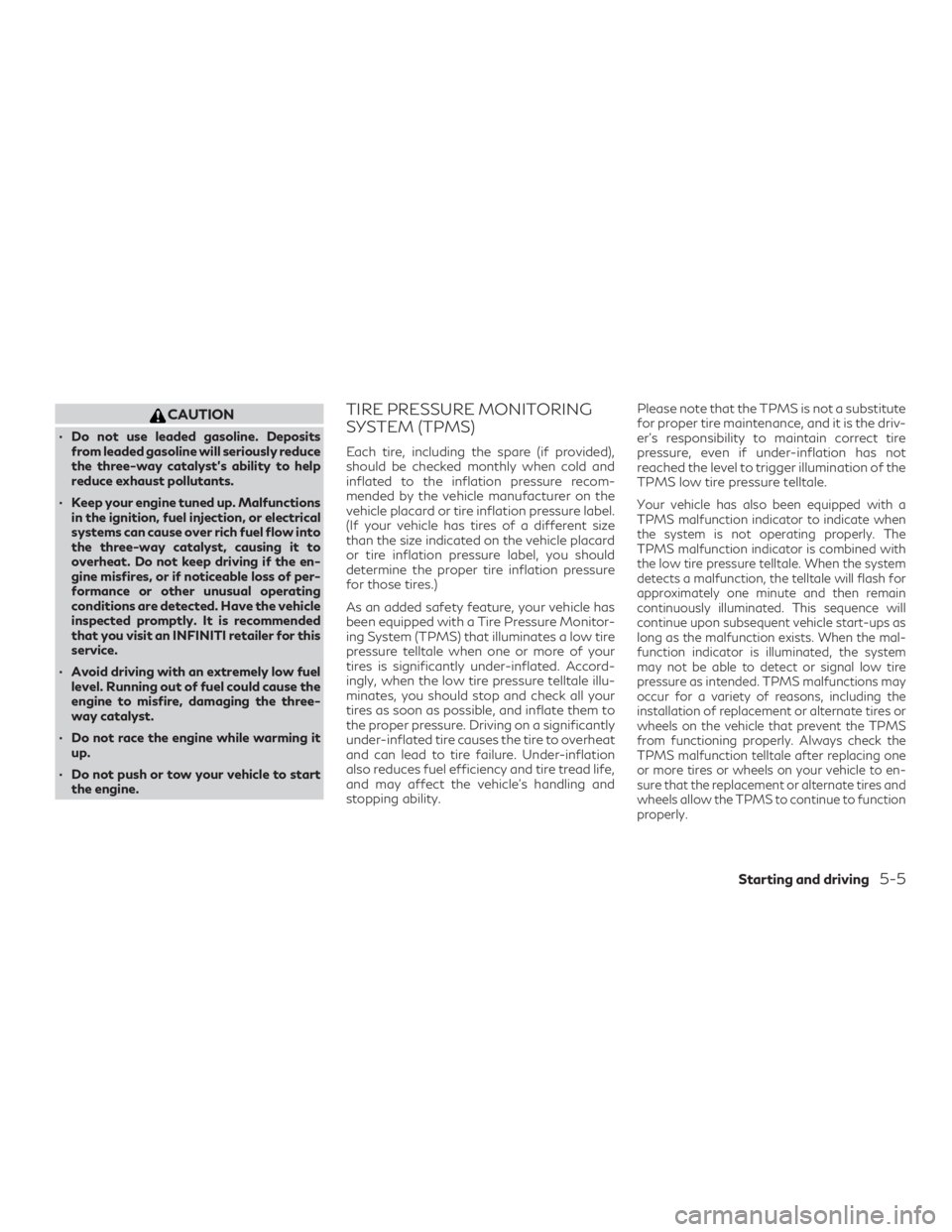
CAUTION
∙ Do not use leaded gasoline. Depositsfrom leaded gasoline will seriously reduce
the three-way catalyst’s ability to help
reduce exhaust pollutants.
∙ Keep your engine tuned up. Malfunctions in the ignition, fuel injection, or electrical
systems can cause over rich fuel flow into
the three-way catalyst, causing it to
overheat. Do not keep driving if the en-
gine misfires, or if noticeable loss of per-
formance or other unusual operating
conditions are detected. Have the vehicle
inspected promptly. It is recommended
that you visit an INFINITI retailer for this
service.
∙ Avoid driving with an extremely low fuel level. Running out of fuel could cause the
engine to misfire, damaging the three-
way catalyst.
∙ Do not race the engine while warming it up.
∙ Do not push or tow your vehicle to start the engine.
TIRE PRESSURE MONITORING
SYSTEM (TPMS)
Each tire, including the spare (if provided),
should be checked monthly when cold and
inflated to the inflation pressure recom-
mended by the vehicle manufacturer on the
vehicle placard or tire inflation pressure label.
(If your vehicle has tires of a different size
than the size indicated on the vehicle placard
or tire inflation pressure label, you should
determine the proper tire inflation pressure
for those tires.)
As an added safety feature, your vehicle has
been equipped with a Tire Pressure Monitor-
ing System (TPMS) that illuminates a low tire
pressure telltale when one or more of your
tires is significantly under-inflated. Accord-
ingly, when the low tire pressure telltale illu-
minates, you should stop and check all your
tires as soon as possible, and inflate them to
the proper pressure. Driving on a significantly
under-inflated tire causes the tire to overheat
and can lead to tire failure. Under-inflation
also reduces fuel efficiency and tire tread life,
and may affect the vehicle’s handling and
stopping ability. Please note that the TPMS is not a substitute
for proper tire maintenance, and it is the driv-
er’s responsibility to maintain correct tire
pressure, even if under-inflation has not
reached the level to trigger illumination of the
TPMS low tire pressure telltale.
Your vehicle has also been equipped with a
TPMS malfunction indicator to indicate when
the system is not operating properly. The
TPMS malfunction indicator is combined with
the low tire pressure telltale. When the system
detects a malfunction, the telltale will flash for
approximately one minute and then remain
continuously illuminated. This sequence will
continue upon subsequent vehicle start-ups as
long as the malfunction exists. When the mal-
function indicator is illuminated, the system
may not be able to detect or signal low tire
pressure as intended. TPMS malfunctions may
occur for a variety of reasons, including the
installation of replacement or alternate tires or
wheels on the vehicle that prevent the TPMS
from functioning properly. Always check the
TPMS malfunction telltale after replacing one
or more tires or wheels on your vehicle to en-
sure that the replacement or alternate tires and
wheels allow the TPMS to continue to function
properly.
Starting and driving5-5
Page 270 of 580
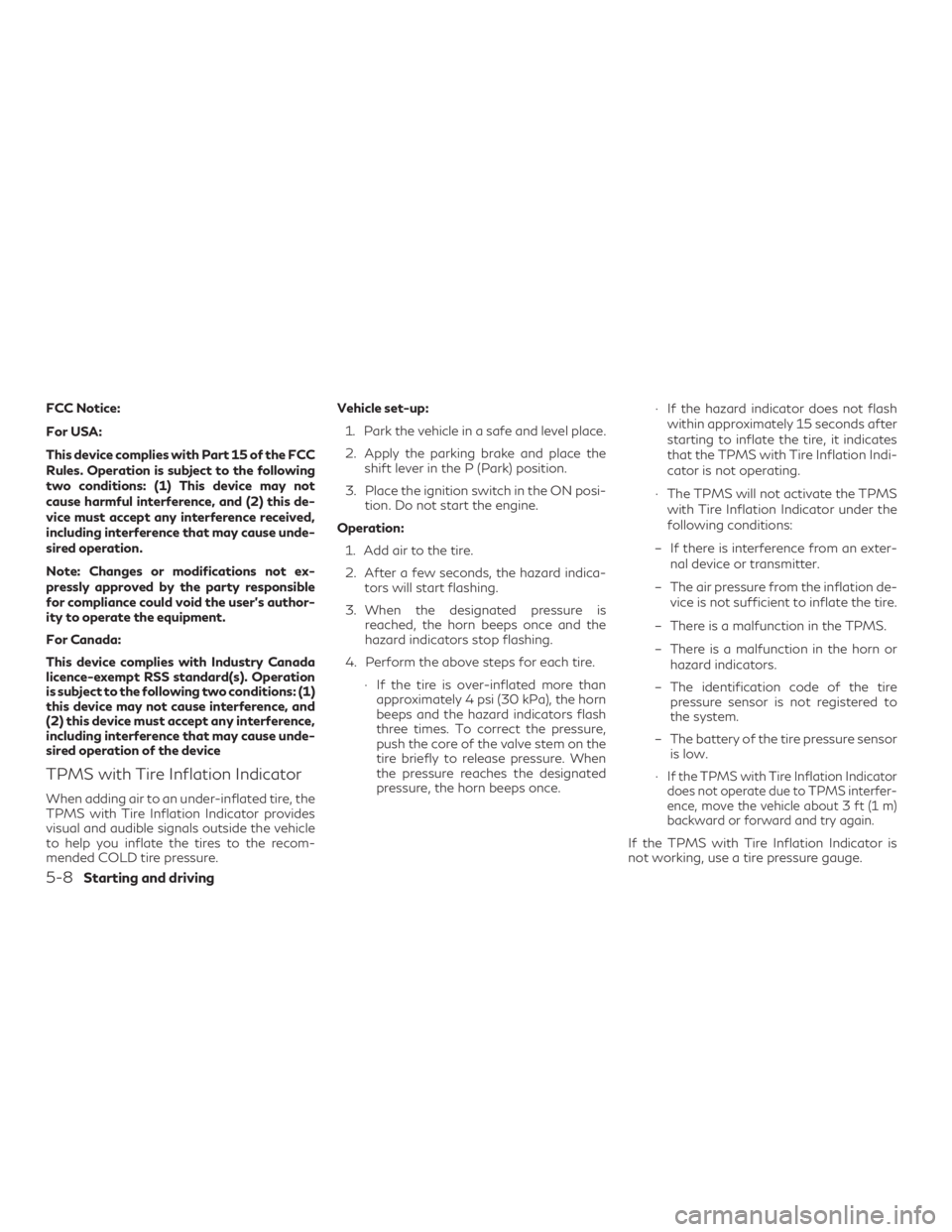
FCC Notice:
For USA:
This device complies with Part 15 of the FCC
Rules. Operation is subject to the following
two conditions: (1) This device may not
cause harmful interference, and (2) this de-
vice must accept any interference received,
including interference that may cause unde-
sired operation.
Note: Changes or modifications not ex-
pressly approved by the party responsible
for compliance could void the user’s author-
ity to operate the equipment.
For Canada:
This device complies with Industry Canada
licence-exempt RSS standard(s). Operation
is subject to the following two conditions: (1)
this device may not cause interference, and
(2) this device must accept any interference,
including interference that may cause unde-
sired operation of the device
TPMS with Tire Inflation Indicator
When adding air to an under-inflated tire, the
TPMS with Tire Inflation Indicator provides
visual and audible signals outside the vehicle
to help you inflate the tires to the recom-
mended COLD tire pressure.Vehicle set-up:
1. Park the vehicle in a safe and level place.
2. Apply the parking brake and place the shift lever in the P (Park) position.
3. Place the ignition switch in the ON posi- tion. Do not start the engine.
Operation: 1. Add air to the tire.
2. After a few seconds, the hazard indica- tors will start flashing.
3. When the designated pressure is reached, the horn beeps once and the
hazard indicators stop flashing.
4. Perform the above steps for each tire. ∙ If the tire is over-inflated more thanapproximately 4 psi (30 kPa), the horn
beeps and the hazard indicators flash
three times. To correct the pressure,
push the core of the valve stem on the
tire briefly to release pressure. When
the pressure reaches the designated
pressure, the horn beeps once. ∙ If the hazard indicator does not flash
within approximately 15 seconds after
starting to inflate the tire, it indicates
that the TPMS with Tire Inflation Indi-
cator is not operating.
∙ The TPMS will not activate the TPMS with Tire Inflation Indicator under the
following conditions:
– If there is interference from an exter- nal device or transmitter.
– The air pressure from the inflation de- vice is not sufficient to inflate the tire.
– There is a malfunction in the TPMS.
– There is a malfunction in the horn or hazard indicators.
– The identification code of the tire pressure sensor is not registered to
the system.
– The battery of the tire pressure sensor is low.
∙
If the TPMS with Tire Inflation Indicator
does not operate due to TPMS interfer-
ence, move the vehicle about 3 ft (1 m)
backward or forward and try again.
If the TPMS with Tire Inflation Indicator is
not working, use a tire pressure gauge.
5-8Starting and driving
Page 273 of 580
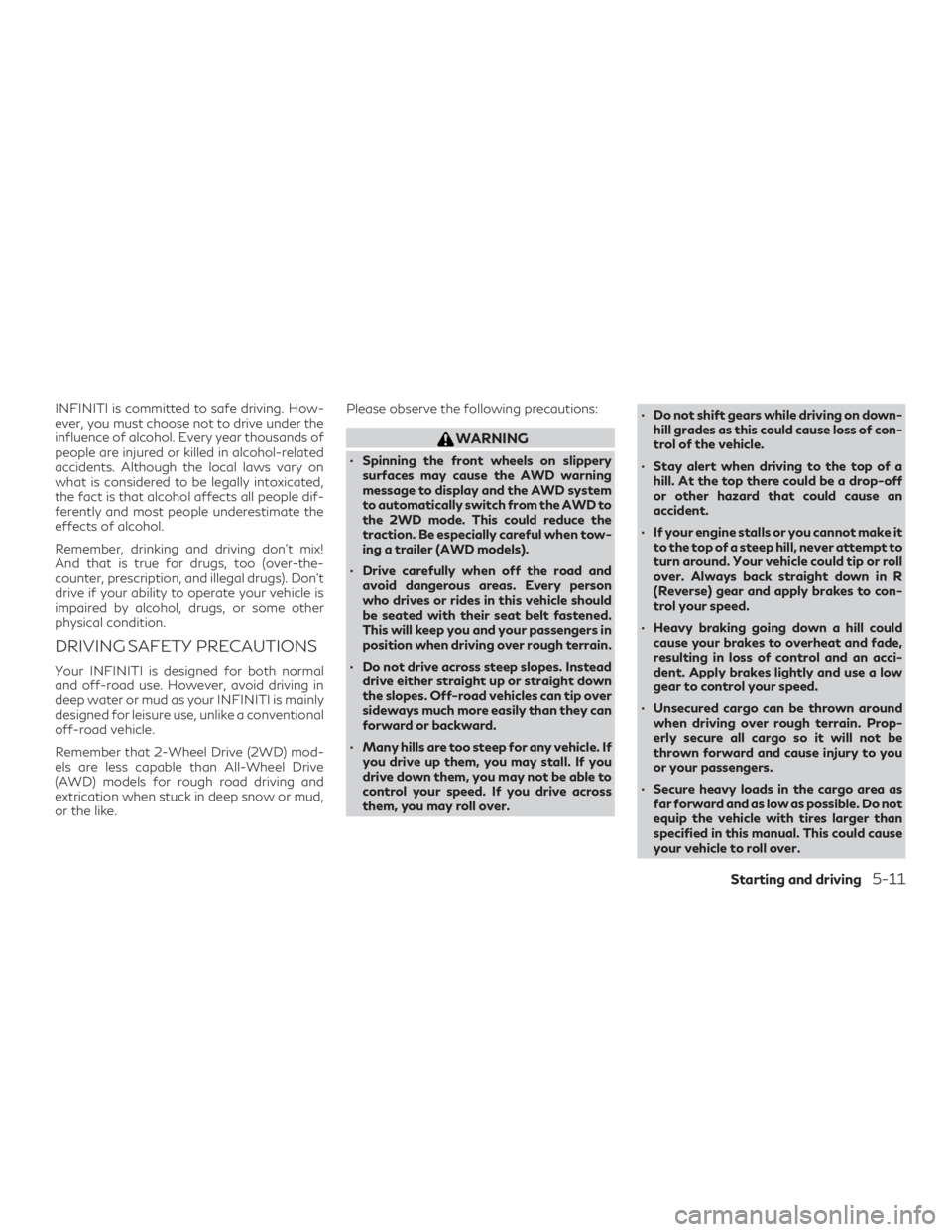
INFINITI is committed to safe driving. How-
ever, you must choose not to drive under the
influence of alcohol. Every year thousands of
people are injured or killed in alcohol-related
accidents. Although the local laws vary on
what is considered to be legally intoxicated,
the fact is that alcohol affects all people dif-
ferently and most people underestimate the
effects of alcohol.
Remember, drinking and driving don’t mix!
And that is true for drugs, too (over-the-
counter, prescription, and illegal drugs). Don’t
drive if your ability to operate your vehicle is
impaired by alcohol, drugs, or some other
physical condition.
DRIVING SAFETY PRECAUTIONS
Your INFINITI is designed for both normal
and off-road use. However, avoid driving in
deep water or mud as your INFINITI is mainly
designed for leisure use, unlike a conventional
off-road vehicle.
Remember that 2-Wheel Drive (2WD) mod-
els are less capable than All-Wheel Drive
(AWD) models for rough road driving and
extrication when stuck in deep snow or mud,
or the like.Please observe the following precautions:
WARNING
∙ Spinning the front wheels on slippery
surfaces may cause the AWD warning
message to display and the AWD system
to automatically switch from the AWD to
the 2WD mode. This could reduce the
traction. Be especially careful when tow-
ing a trailer (AWD models).
∙ Drive carefully when off the road and avoid dangerous areas. Every person
who drives or rides in this vehicle should
be seated with their seat belt fastened.
This will keep you and your passengers in
position when driving over rough terrain.
∙ Do not drive across steep slopes. Instead drive either straight up or straight down
the slopes. Off-road vehicles can tip over
sideways much more easily than they can
forward or backward.
∙ Many hills are too steep for any vehicle. If you drive up them, you may stall. If you
drive down them, you may not be able to
control your speed. If you drive across
them, you may roll over. ∙ Do not shift gears while driving on down-
hill grades as this could cause loss of con-
trol of the vehicle.
∙ Stay alert when driving to the top of a hill. At the top there could be a drop-off
or other hazard that could cause an
accident.
∙ If your engine stalls or you cannot make it to the top of a steep hill, never attempt to
turn around. Your vehicle could tip or roll
over. Always back straight down in R
(Reverse) gear and apply brakes to con-
trol your speed.
∙ Heavy braking going down a hill could cause your brakes to overheat and fade,
resulting in loss of control and an acci-
dent. Apply brakes lightly and use a low
gear to control your speed.
∙ Unsecured cargo can be thrown around when driving over rough terrain. Prop-
erly secure all cargo so it will not be
thrown forward and cause injury to you
or your passengers.
∙ Secure heavy loads in the cargo area as far forward and as low as possible. Do not
equip the vehicle with tires larger than
specified in this manual. This could cause
your vehicle to roll over.
Starting and driving5-11
Page 274 of 580

∙ Do not grip the inside or spokes of thesteering wheel when driving off-road.
The steering wheel could move suddenly
and injure your hands. Instead drive with
your fingers and thumbs on the outside of
the rim.
∙ Before operating the vehicle, ensure that the driver and all passengers have their
seat belts fastened.
∙ Always drive with the floor mats in place as the floor may become hot.
∙ Lower your speed when encountering strong crosswinds. With a higher center
of gravity, your INFINITI is more affected
by strong side winds. Slower speeds en-
sure better vehicle control.
∙ Do not drive beyond the performance ca- pability of the tires, even with AWD
engaged.
∙ For AWD equipped vehicles, do not at- tempt to raise two wheels off the ground
and shift the transmission to any drive or
reverse position with the engine running.
Doing so may result in drivetrain damage
or unexpected vehicle movement which
could result in serious vehicle damage or
personal injury. ∙ Do not attempt to test an AWD equipped
vehicle on a 2-wheel dynamometer (such
as the dynamometers used by some
states for emissions testing) or similar
equipment even if the other two wheels
are raised off the ground. Make sure you
inform test facility personnel that your
vehicle is equipped with AWD before it is
placed on a dynamometer. Using the
wrong test equipment may result in
drivetrain damage or unexpected vehicle
movement which could result in serious
vehicle damage or personal injury.
∙ When a wheel is off the ground due to an unlevel surface, do not spin the wheel
excessively.
∙ Accelerating quickly, sharp steering ma- neuvers or sudden braking may cause loss
of control.
∙ If at all possible, avoid sharp turning ma- neuvers, particularly at high speeds. Your
INFINITI vehicle has a higher center of
gravity than a passenger car. The vehicle
is not designed for cornering at the same
speeds as passenger cars. Failure to op-
erate this vehicle correctly could result in
loss of control and/or a rollover accident. ∙ Always use tires of the same type, size,
brand, construction (bias, bias-belted, or
radial), and tread pattern on all four
wheels. Install tire chains on the front
wheels when driving on slippery roads
and drive carefully.
∙ Be sure to check the brakes immediately after driving in mud or water. For addi-
tional information, refer to “Brake pre-
cautions” in this section.
∙ Avoid parking your vehicle on steep hills. If you get out of the vehicle and it rolls
forward, backward or sideways, you
could be injured.
∙ Whenever you drive off-road through sand, mud or water as deep as the wheel
hub, more frequent maintenance may be
required. For additional information, re-
fer to “Maintenance under severe oper-
ating conditions” in the “Maintenance
and schedules” section of this manual.
5-12Starting and driving
Page 275 of 580
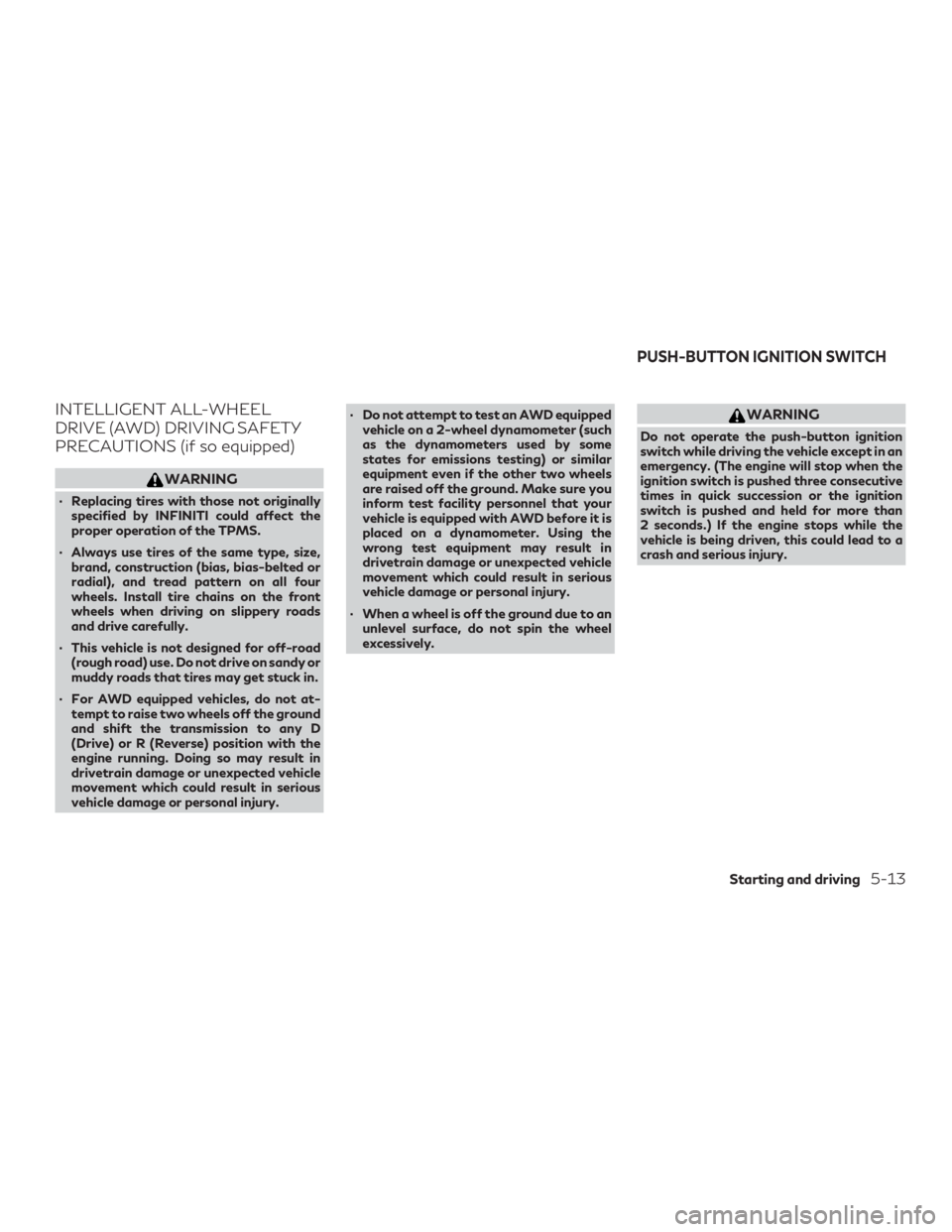
INTELLIGENT ALL-WHEEL
DRIVE (AWD) DRIVING SAFETY
PRECAUTIONS (if so equipped)
WARNING
∙ Replacing tires with those not originallyspecified by INFINITI could affect the
proper operation of the TPMS.
∙ Always use tires of the same type, size, brand, construction (bias, bias-belted or
radial), and tread pattern on all four
wheels. Install tire chains on the front
wheels when driving on slippery roads
and drive carefully.
∙ This vehicle is not designed for off-road (rough road) use. Do not drive on sandy or
muddy roads that tires may get stuck in.
∙ For AWD equipped vehicles, do not at- tempt to raise two wheels off the ground
and shift the transmission to any D
(Drive) or R (Reverse) position with the
engine running. Doing so may result in
drivetrain damage or unexpected vehicle
movement which could result in serious
vehicle damage or personal injury. ∙ Do not attempt to test an AWD equipped
vehicle on a 2-wheel dynamometer (such
as the dynamometers used by some
states for emissions testing) or similar
equipment even if the other two wheels
are raised off the ground. Make sure you
inform test facility personnel that your
vehicle is equipped with AWD before it is
placed on a dynamometer. Using the
wrong test equipment may result in
drivetrain damage or unexpected vehicle
movement which could result in serious
vehicle damage or personal injury.
∙ When a wheel is off the ground due to an unlevel surface, do not spin the wheel
excessively.
WARNING
Do not operate the push-button ignition
switch while driving the vehicle except in an
emergency. (The engine will stop when the
ignition switch is pushed three consecutive
times in quick succession or the ignition
switch is pushed and held for more than
2 seconds.) If the engine stops while the
vehicle is being driven, this could lead to a
crash and serious injury.
PUSH-BUTTON IGNITION SWITCH
Starting and driving5-13
Page 276 of 580

When the ignition switch is pushed without
depressing the brake pedal, the ignition
switch will change as follows:
Push the ignition switch center:∙ Once to change to ON.
∙ Two times to change to OFF.
The ignition switch will automatically return
to the LOCK position when any door is either
opened or closed with the switch in the OFF
position. The ignition lock is designed so that the igni-
tion switch cannot be placed in the OFF po-
sition until the shift lever is in the P (Park)
position.
When the ignition switch cannot be placed in
the OFF position, proceed as follows:
1. Press the Park button to place the ve- hicle in the P (Park) position.
2. Push the ignition switch. The ignition switch position will change to the ON
position.
3. Push the ignition switch again to the OFF position.
The shift lever can be moved from the P
(Park) position if the ignition switch is in the
ON position and the brake pedal is de-
pressed.
If the battery of the vehicle is discharged, the
ignition switch cannot be moved from the
LOCK position.
Some indicators and warnings for operation
are displayed on the vehicle information dis-
play. For additional information, refer to “Ve-
hicle information display” in the “Instruments
and controls” section of this manual.OPERATING RANGE
The Intelligent Key functions can only be used
when the Intelligent Key is within the speci-
fied operating range.
When the Intelligent Key battery is almost
discharged or strong radio waves are present
near the operating location, the Intelligent
Key system’s operating range becomes nar-
rower and may not function properly.
If the Intelligent Key is within the operating
range, it is possible for anyone, even some-
one who does not carry the Intelligent Key, to
push the ignition switch to start the engine.
LSD2911LSD2020
5-14Starting and driving